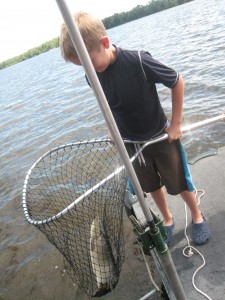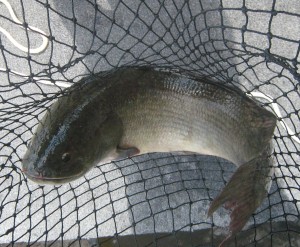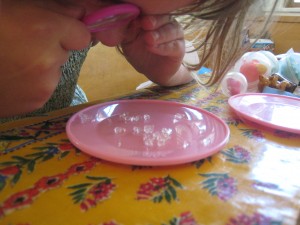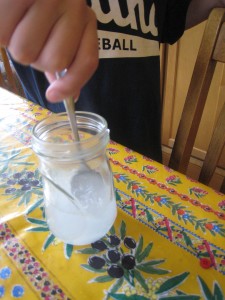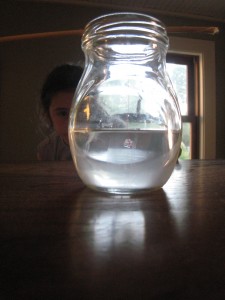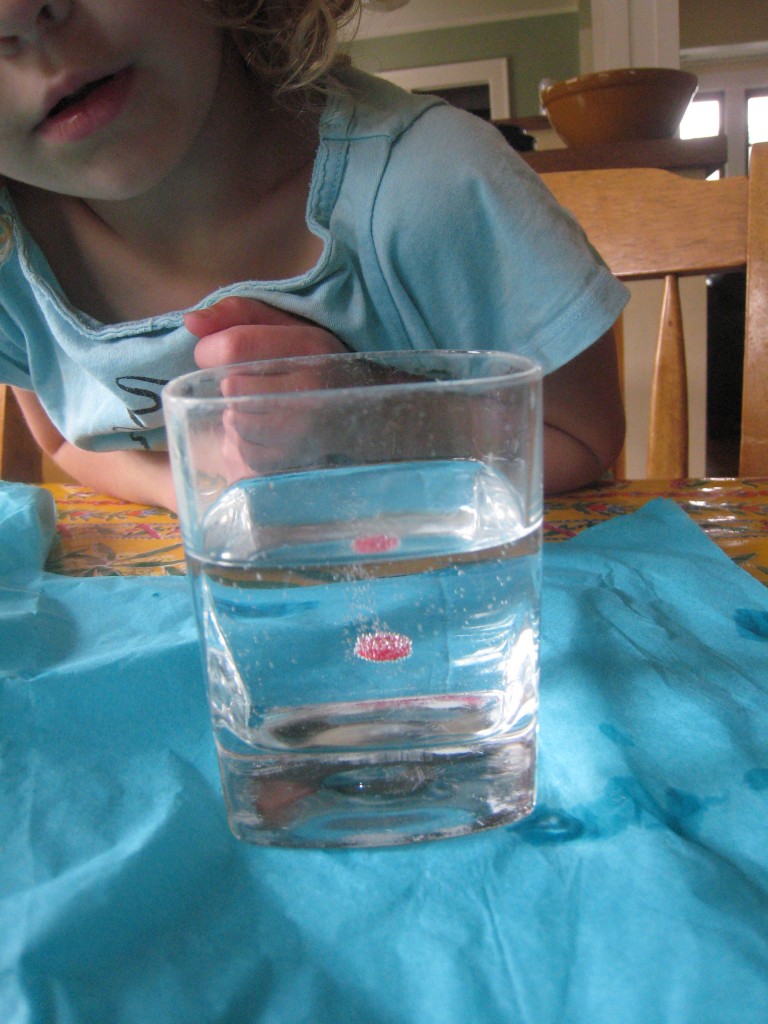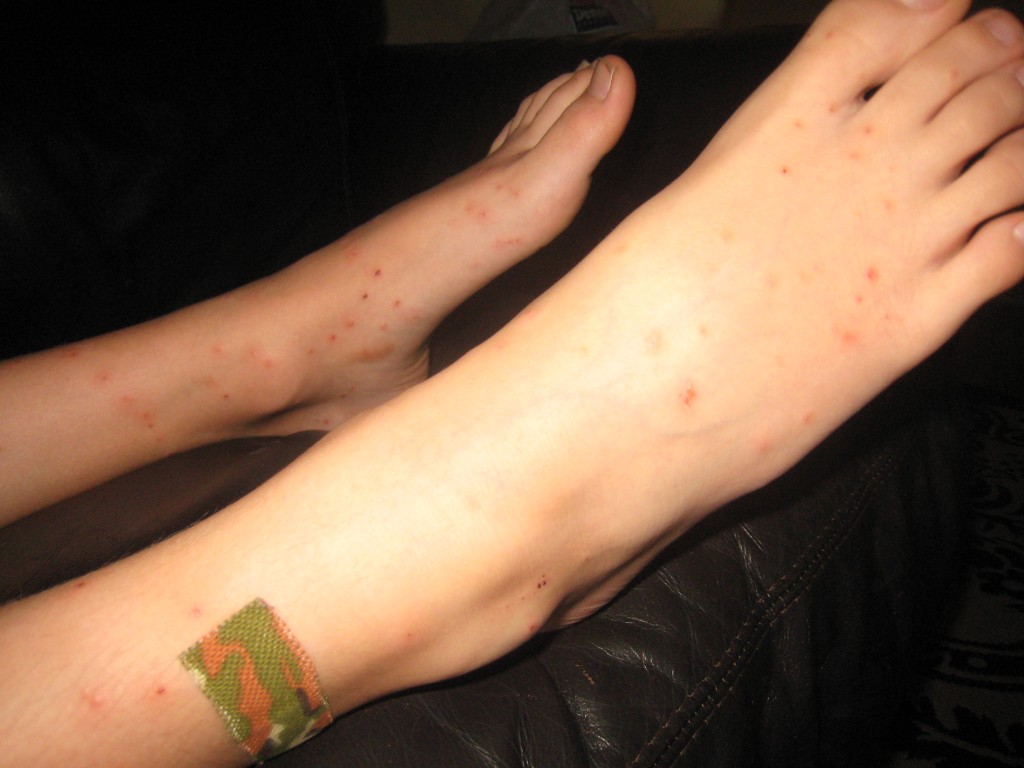Tag: science’
Red Cabbage Litmus Paper
- by KitchenPantryScientist
This is a great science project and produces beautifully colored paper that can be dried and used for art projects like collages.

All you’ll need is a head of red cabbage and some paper towels. Alternately, you can just use the juice from canned red cabbage. I’d recommend wearing an old tee shirt or a home-made lab coat for this project, since I’m guessing that cabbage juice will stain. To make a lab coat, just have kids write their name in permanent marker on the pocket of a man’s old button-down shirt. They’ll love it!
Chop half a head of red cabbage into small pieces and add it to a pan with about a cup of water. Boil the cabbage uncovered for about 15 minutes, stirring occasionally, let it cool, and strain the juice into a jar or bowl. (Save the cooked cabbage for your favorite recipe and make cole slaw with the other half!)

Cut the paper towels into strips about an inch wide and a few inches long and soak them in the cabbage juice for about a minute. Remove them and let them dry on something that won’t stain. I blotted them a little to speed up the drying process. You might even try using a blow dryer!
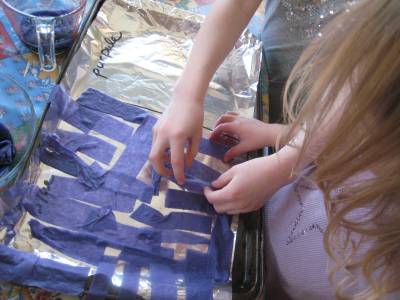
When dry, your litmus paper will be ready to use for testing acidity. Your can dip the paper into orange juice, soapy water, lemon juice, baking soda in water, baking powder in water, vinegar, and anything else they want to test. The paper will turn red-pink in acids and blue or green in bases. Even very young children will love this experiment! The colors we saw were amazing. Have your child tape a strip or two of the paper into their lab notebooks.
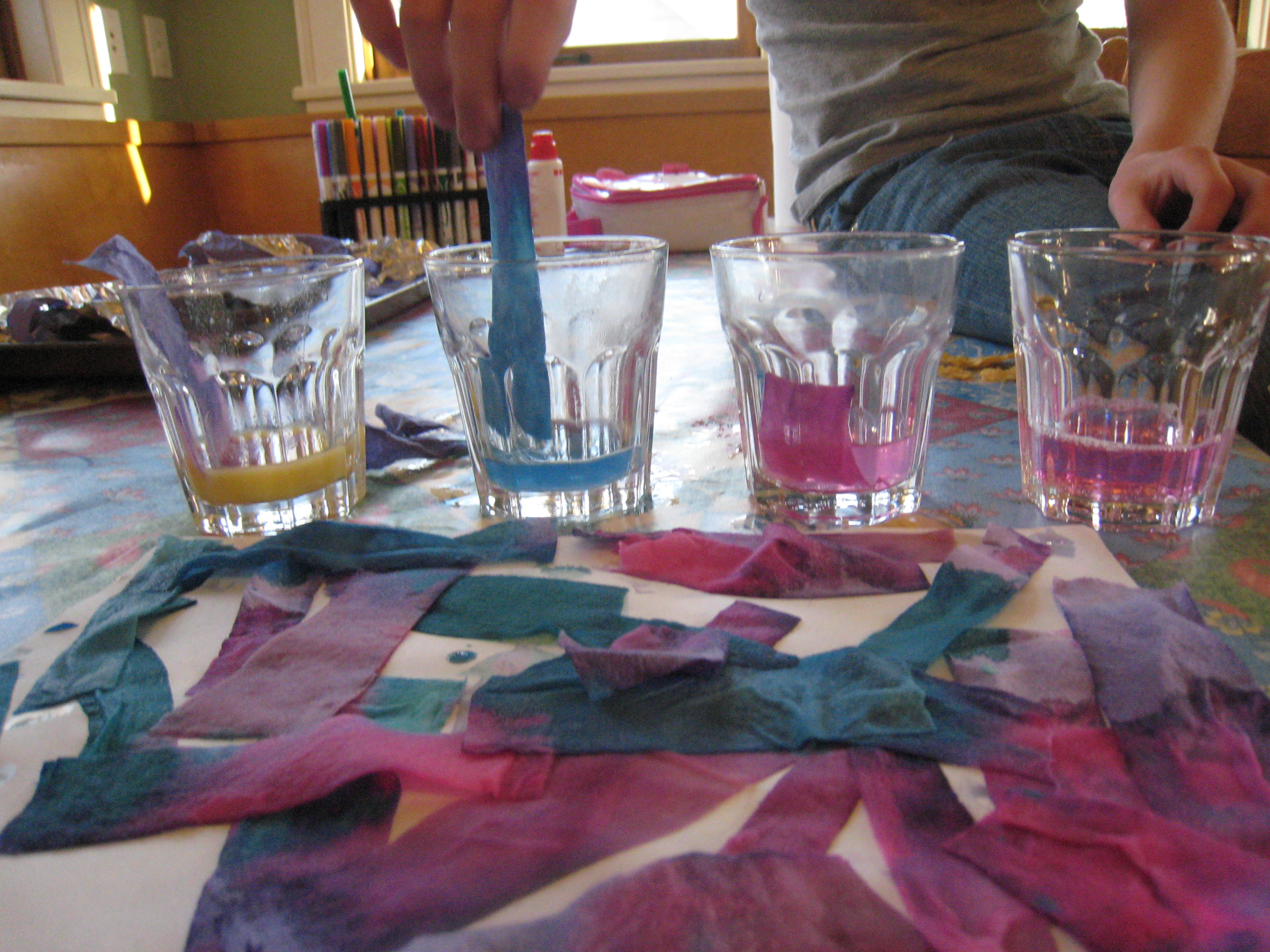
Everything in our world is made of very tiny pieces called atoms. Atoms are so small that if you blow up a balloon, it will contain about a hundred billion billion atoms of the gases that make up air. Atoms are often bonded to other atoms to form a group of linked atoms called a molecule. A water molecule, for example, has two hydrogen atoms and one oxygen atom, bonded together.
Acids that usually dissolve in water to form free-floating hydrogen atoms. Bases are the opposite and take up free hydrogen atoms. The molecules in the cabbage juice litmus paper change when exposed to an acid or base, making the paper change color.
Now I know why my mom’s delicious Pennsylvania Red Cabbage recipe turns red when we add the vinegar!
Prehistoric Monster
- by KitchenPantryScientist
“Mom! I caught a big Northern!” my son screamed at me. I ran to get the net, excited that he’d finally hooked a big one, right off our dock.
When I got the net around the fighting fish though, I was sure it wasn’t a Northern Pike. We took pictures of the huge, gray creature and were lucky enough to have it wriggle off the hook before we donned gloves to try to get it off ourselves. I guessed that it was a bowfin, based on the long fin running down its back and a neighbor’s report of catching one on the same lake. We confirmed it online when we got home.
Along with gar and sturgeons, bowfin are in an order of primitive, ray-fin fish that have survived since the time of the dinosaurs. They can grow to 43 inches and weigh up to 21 pounds. My son’s weighed between 5 and 10 pounds and I’m glad we didn’t have him try to hold it up for a photo, since bowfin have very sharp teeth and will bite anyone who attempts to handle them. We released the fish and watched him disappear into the deep.
The kids were a little afraid to swim off the dock after that. I don’t blame them. Who wants to go swimming in the lair of a prehistoric monster?
Alum Crystal Mine
- by KitchenPantryScientist
Imagine pieces of matter (too small to see) called atoms that will only fit together in a certain way, like a puzzle. These atoms can attach to each other to form small three-dimensional shapes, or larger ones, but the shape will always be the same, depending on what kind of atoms make up the “puzzle pieces.”
This is what happens when crystals are formed. Diamonds and salt, for example, are crystals shaped like cubes, while quartz crystals are formed in trigonal shapes, sort of like three-dimensional kites. You can have very small diamonds, or huge ones, like the Hope Diamond, which is as big as a silver dollar and blue from impurities in the stone, but they will all have the same basic shape.
We grew alum crystals in a jar last week and I am amazed at how beautiful they are. I couldn’t get a very good picture, but they look like a string of real gems and were simple to grow.
To grow these spectacular crystals, you will need a small jar of alum, which can be found with the spices at the grocery store, water, a glass, a jar, a stick and some thread.
Fill the glass with about 3/4 cup of water and add a few teaspoons of alum powder. Stir until the powder dissolves and repeat until no more alum will dissolve and you can still see some floating around in the glass. Then, let the glass sit overnight or until some small alum crystals form in the bottom or on the sides of the cup. It took two days for us to get some decent crystals, but we got several small ones that were fun to look at!
Fish a large crystal out of the glass with a spoon and tie a thread around it. Tie the other end of the thread around the stick (we used a BBQ skewer) and wind it up so that you can rest the stick over the mouth of the jar and the crystal will hang down about half way. Then, pour the remaining liquid from the cup into the jar. There is still alum in the water, which will add more “puzzle pieces” to the crystal and make it grow bigger.
Now you can watch your crystal grow. What shape is it? Look at your crystals under a magnifying glass. Take a picture of them, or draw them your science notebook! Here is a link to a great Smithsonian website where you can learn more about gems and crystals.
Buttons Afloat
- by KitchenPantryScientist
Here’s a quick experiment for bored kids:
You’ll need a button, a glass, water, and a carbonated beverage.
Pour some water in the glass. Drop the button in. What happens?
If it sinks*, dump the water out and fill the glass with carbonated beverage. Drop the button in. Now what happens?
The button is more dense than the water and sinks in uncarbonated water, but in a carbonated beverage, carbon dioxide bubbles form on the button and make it buoyant, so it floats to the top.
What other sinking objects can you make float with carbonation?
If your kids like this, check out this Float or Sink experiment that even very young kids can do!
*If your button floats, the experiment won’t work, so try to find one that sinks!
Fun Science Contest for 6-12th Graders
- by KitchenPantryScientist
This morning, Twitter led me to a great website filled with science news for kids. Check it out at http://sciencenewsforkids.com/.
The Society for Science and the public, who sponsors the site, is having a contest for kids in grades 6-12 where they can enter their own podcast talking about what they’ve learned about science from the website. Go here for more details.
It sounds like a great way to keep your kids reading about science this summer!
We are the Whales
- by KitchenPantryScientist
Whale hunting has been in the new a lot recently, but it now appears that the biggest threat to these intelligent, majestic animals is no longer whalers’ harpoons.
I read this morning in the Star Tribune that “Sperm whales, feeding even in the most remote reaches of Earth’s oceans, have built up stunningly high levels of toxic and heavy metals.” Most of these contaminants have been introduced into the ocean by humans of course. The article goes on to talk about how our food supply is being threatened by our poisoned oceans and that seafood is a primary source of protein for over 1 billion people. Do you eat fish?
Apparently, high concentrations of these poisons collect in these whales because they are at the top of the food chain. That means they eat fish and squid that have eaten smaller animals, which have eaten yet smaller animals and plants and so on. Humans are also at the top of the food chain, and although we don’t only eat contaminated fish, we eat many other plants and animals that are exposed to heavy metals, pesticides and herbicides. Both whales and humans nurse their young, passing contaminants from mother to baby. (That beautiful piece of wild salmon may not be as pristine as you’ve convinced yourself that it is. Like it or not, our bodies are full of toxins too.)
What’s happening to the whales is happening to us. The difference is that the whales are not the ones polluting the world.
Look at the Gulf. Looks at our sick oceans. Go read “The Lorax.”
We have to save the whales to save ourselves.
Beware the Pretty Birds!
- by KitchenPantryScientist
We spent last week in Iowa at a family reunion at lake Okoboji, a deep, clear, gorgeous lake near the Minnesota border. My great grandparents had a cottage there, and every year my mom’s side of the family returns to spend a week swimming, fishing, going to the lakeside amusement park and just hanging out.
Gull Point is a pretty piece of land with a sandy beach and sandbar that juts out into the lake and is one of our favorite destinations. Each year we spend an afternoon or two there, swimming, skipping rocks and digging our toes into the sand. We didn’t see many gulls this year, but there was a pretty white pelican hanging out nearby. Little did I know that water birds carry a tiny parasite that infects snails in the water. The parasite’s larvae are then released and swim around looking for a suitable mammalian host to burrow into and continue their life cycle.
Ignorant of the tiny bugs digging into our skin, we frolicked in the water for hours.
Humans are not a good host for these parasites and they soon die, leaving their buggy corpses under our skin. Some people don’t have much of a reaction, but others have immunes systems that kick into high gear, rejecting the dead parasites with an inflammatory response in the the form of big, itchy, awful bumps.
My son is definitely allergic. The CDC website has more information on Swimmer’s Itch, or Cercarial Dermatitis, which can also be found in many Minnesota lakes. Generally, it doesn’t need much treatment except Hydrocortisone cream or Calamine lotion. My daughter and I have a few itchy bumps, but nothing major. My son, on the other hand is on oral prednisone too calm his allergic reaction. Needless to say, it has been a long, long week.
According to the University of Minnesota’s Extension Service, you can do the following things to reduce your chances of getting severe swimmer’s itch:
- Dry off as soon as you leave the water. Rub skin briskly to remove water drops before they evaporate. Be sure to dry underneath waistbands and around leg openings. Encourage children to dry off thoroughly each time they leave the water.
- Shower with soap and fresh water or change into dry clothes as soon as possible.
- Don’t wade or play in shallow water. Swimming from a raft or pontoon minimizes your exposure.
- Don’t feed geese and ducks near your beach. Waterfowl are an important adult host for the parasites.
You can also go to http://checkmylake.com to search for specific lakes to see if they’re safe for your family to swim in. I wish I would have checked!
Static Fun
- by KitchenPantryScientist
It’s been raining for about two weeks straight in Minnesota and my kids are climbing the walls. Yesterday, they built an amazing fort and played in it for an hour before they came to me asking what they could do next.
This easy experiment kept them busy for a little while.
Take a plastic comb and comb your hair a number of times, or rub it on some tissue paper. Tiny charged particles called electrons will collect on the comb and give it a negative charge.
Now, run a very thin stream of water from a faucet and hold the comb next to it without actually touching the water. What happens?
The stream of water is positively charged and is attracted to the opposite (negative) charge of the comb, pulling and bending the stream of water toward the comb.
Pretty cool.
Many more experiments to follow in the next few months! We’re planning a summer of science between our many sporting activities, so get those science notebooks ready and follow along with us!
Father’s Day at the Science Museum
- by KitchenPantryScientist
I just got this email from the Science Museum of Minnesota and thought I’d share it with you. It sounds like a great way to spend Father’s Day!
Father’s Day – Sunday, June 20, 2010 – 12 p.m. to 5 p.m.
at the Science Museum of Minnesota
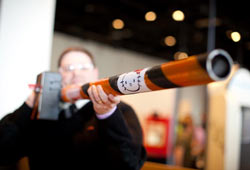 Make: Day at the Science Museum is this Father’s Day—Sunday, June 20, 2010. Mark your calendars for the chance to meet with an astounding group of local engineers, artists, tinkerers, and inventors. They’ve been hard at work, and now they want to share their DIY creations with you.
Make: Day at the Science Museum is this Father’s Day—Sunday, June 20, 2010. Mark your calendars for the chance to meet with an astounding group of local engineers, artists, tinkerers, and inventors. They’ve been hard at work, and now they want to share their DIY creations with you.
Presentations to see, hear, and interact with include:
- A 3D Printer that makes plastic models from computer designs right before your eyes
- A potential Guinness World Record-breaking attempt using kinetic gadgets
- Musical performances by experimental musicians using custom-built instruments
- A bicycle ride across a suspended cable
- Plus a whole lot more!
You’ll have the opportunity to meet with the makers, ask them about their inventions, and learn about ways that you can get involved with local making communities. Presentations will be located throughout the museum’s exhibit galleries. The event is included with regular museum admission.
Dads get in free to Make: Day!
Make: Day is a great way to celebrate Father’s Day with the whole family. With all the amazing DIY presentations, there’s sure to be something for everyone. And don’t forget to take advantage of the incredible opportunity for dads to get in free with the Make: Day Father’s Day coupon. Just print it out and present it at the box office along with any full-price ticket purchase. The free admission is good for any exhibit combination, including the Omnitheater and The Dead Sea Scrolls. So bring your DIY (or not-so-DIY) dad down and see what’s being made!
Oil Spill Experiment Revisited
- by KitchenPantryScientist
I first posted this experiment on May 5, certain that the spill would soon be contained. Now we know it’s worse than we imagined and no immediate solution is in sight. If your kids don’t understand why it’s so hard to help the birds, have them try this project.
The oil spill in the Gulf of Mexico is devastating news to the already fragile and damaged ecosystems in the area. To demonstrate how hard it is to remove oil from water, and what materials work best, I found this experiment online at tryscience.org and decided to have my kids try it. It was messy and disgusting and oil got all over everything. In other words, it was a great demonstration of how hard it will be to clean up the mess made by BP’s Deepwater Horizen oil rig, which exploded on April 20th.
You’ll need a clear bowl, water, yellow oil (vegetable, corn or canola will work,) cotton balls, cheese cloth, polyester cloth (the website said polypropylene, but I couldn’t find any,) feathers, and a spoon.
Put some water in the bowl and pour in some oil. I probably added a cup so it would cover the water. Then, using spoons and the other materials, try to remove the oil from the water. What works best?
We put our feathers in oil and then tried to clean them off using dish soap and water, which is how they clean off marine birds covered with oil following oil spills.
Polypropylene is a synthetic material made from Carbon and Hydrogen, the same elements in oil. Oil is attracted to polypropylene, and both float on water, so polypropylene is often used in cleaning up oil spills. You can also find it in gloves and sock liners.
If one cup of oil is this hard to clean up, can you imagine the mess pouring into the Gulf of Mexico right now, at the rate of about 210,000 gallons a day (according to the New York Times.) Here is a link to a map that is tracking the spill.
